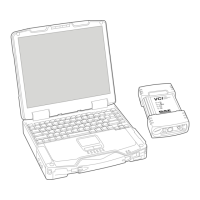©
200706 7-1
Guided Diagnosis
DAVIE XDc II
7 GUIDED DIAGNOSIS
7.1 Principle op of Guided Diagnosis
Guided Diagnosis is primarily used to determine (point out) the possibly
defective elements (components). Where the function "Direct Testing" has to be
used for programming, calibrating or to directly test specific components,
"Guided Diagnosis" presents tests only based on the elements which are
suspected to be defective.
Why using Guided Diagnosis?
• If you want to confirm suspicion without exchanging parts by trial & error
• If you don't know which components to suspect
• If you have a lack of knowledge about a vehicle function
• If an error status is unclear (active/not active) symptoms can be used
• Guided can and will tell you!
There are different methods, within Guided Diagnosis, to find the suspected
element (component):
1. Based on Fault codes (present in the ECU Fault Memory)
2. Based on Symptoms (deviant behaviour of Systems)
3. A combination of above
The best way to build a Test plan is using Fault codes (1), because this usually
generates a small list of suspected elements.
When no Fault codes are present the Test plan can be build on Symptoms (2).
The list of suspected elements can be much larger.
When Fault codes are present, but the list of suspected elements is still very
large, Symptoms can be added to decrease the list (3).

